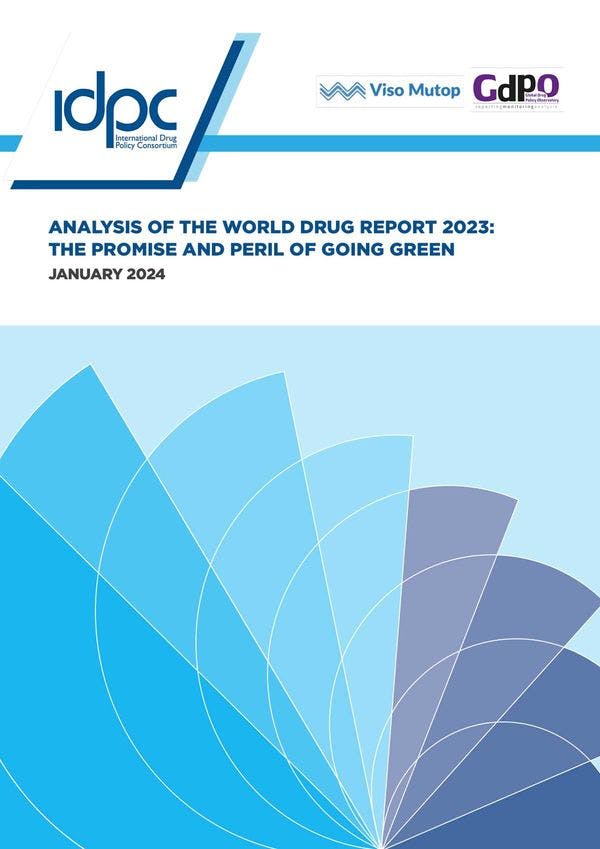Análisis del Informe Mundial sobre las Drogas 2023: La promesa y los límites del viraje verde
El IDPC, Viso Mutop y GDPO analizan el debate del informe sobre los boyantes mercados de la droga y la postura de la ONUDD sobre cuestiones clave como la descriminalización, los derechos humanos y el impacto medioambiental, señalando la creciente influencia de la "criminología verde" y su potencial para remodelar las perspectivas. Más información, en inglés, está disponible abajo.
Executive summary
With a format including not only the continued use of separate booklets, but also a new complementary online web-based element, the World Drug Report 2023 presents – as ever – an impressive array of largely accessible and user-friendly data and analysis of what the United Nations Office on Drugs and Crime (UNODC or Office) continues to refer to as the ‘world drug problem’. In so doing, readers can identify many familiar and predominantly alarming trends regarding the growing scale and increasing complexity of the illegal drug market. We are also informed, again, of ongoing inequalities relating to a range of official responses and policy interventions, including the availability of pharmaceutical opioids for medical consumption and significant barriers to treatment.
As in previous years, the Report remains reticent to explicitly engage in discussion of an array of evidence based approaches, including decriminalisation of drug possession for personal use and harm reduction. Relatedly, the UNODC’s relative lack of engagement with the intersection between drug policy and human rights means that it remains an outlier within the broader UN system; a situation that becomes starker as other agencies and bodies focus ever more explicitly on the connection.
That said, following on from last year’s Report, it is welcome to see the UNODC continue to fix attention on the relationship between drugs and environmental harm. The 2023 publication devotes considerable space to the issue in the form of an in-depth analysis of ‘The Nexus Between Drugs and Crimes that Affect the Environment and Convergent Crime in the Amazon Basin’. It consequently reveals the Office’s emerging use of green criminology as a lens through which to view the increasingly pressing issue. The perspective adopted is important since the UNODC possesses considerable ‘productive power’ to set agendas and shape narratives within international drug control debates. While not alone as a beneficial disciplinary approach, green criminology offers substantial promise for ongoing analysis. Its fundamental ‘critical’ nature, however, means that its deployment is accompanied by significant challenges.
Having explained the selection criteria for the geographical scope of study, the Report analyses the situation within the region using a new ‘preliminary’ conceptual framework through which to better understand the ‘crime ecosystem’. This includes introduction of the concept of convergent crime. Within this context, discussion incorporates the idea of direct and indirect environmental impact (notably deforestation and ‘narco-deforestation’), the related diversification of criminal organisations into a range of illegal markets, and the role of drug trafficking groups in undermining the rule of law and amplifying the impact of criminal economies. Although not without its problems, discussion also focuses to a limited extent on the negative environmental impact of drug policy interventions rather than simply illegal drug markets.
While also limited in scope, the space devoted to communities and Indigenous populations indicates the potential of green criminology to move beyond a preoccupation with criminality and criminal actors and focus instead on the harms associated with, and victims of, illegal markets. To be sure, the approach connects well with discussions of environmental justice and human rights and as such could do much to enhance the UNODC’s limited and cautious engagement to date.
However, if adopted to its fullest extent and in line with the intentions of its founders and key proponents, the structural critique inherent within green criminology generates a key dilemma for the Office: how to deal with the overarching prohibitive paradigm? The approach certainly has the potential to generate a much needed and better understanding of the complex reality within the Amazon Basin, including through the legitimate integration of the drug issue into a broader portfolio of criminal activities and resultant environmental harms. Yet, despite the increasingly obvious ineffective and harmful character of global drug prohibition, the UNODC remains unable to question the system that sustains it and apply the truly holistic and integrated analysis that is required.
Previous reports in this series:
- IDPC analysis of the UNODC World Drug Report 2022
- The World Drug Report 2021: A critical assessment of projected increases in African drug use
- The World Drug Report 2020: Perspectives on markets, technology, and policy
- The World Drug Report 2019: Perspectives on protecting public health
- IDPC response to the 2018 World Drug Report
- IDPC response to the 2017 World Drug Report
- IDPC response to the 2016 World Drug Report
- IDPC response to the 2015 World Drug Report
- IDPC response to the 2014 World Drug Report
- IDPC response to the 2013 World Drug Report
- IDPC response to the 2012 World Drug Report
- IDPC response to the 2011 World Drug Report
- IDPC response to the 2010 World Drug Report
- IDPC response to the 2009 World Drug Report
- IDPC response to the 2008 World Drug Report
- IDPC response to the 2007 World Drug Report
- IDPC response to the 2006 World Drug Report
